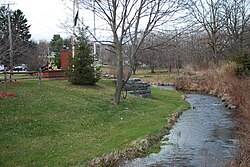Van Wyck Homestead Museum
American Revolution on the National Register of Historic PlacesAmerican Revolutionary War museums in New York (state)American Revolutionary War sitesArchaeological sites on the National Register of Historic Places in New York (state)Fishkill, New York ... and 8 more
Historic house museums in New York (state)Houses completed in 1777Houses in Dutchess County, New YorkHouses on the National Register of Historic Places in New York (state)Museums in Dutchess County, New YorkNational Register of Historic Places in Dutchess County, New YorkU.S. Route 9Van Wyck family

The Van Wyck Homestead Museum or Van Wyck-Wharton House (pronounced Van Wike) is an early 18th-century Dutch colonial house in the Town of Fishkill, New York, United States of America. It served as a headquarters to a major military supply depot during the American Revolutionary War and has been listed on the National Register of Historic Places since April 13, 1972; the adjoining Fishkill Supply Depot Site has been listed on the NRHP since January 21, 1974. It is located on US 9 just south of Interstate 84. Excavations during the construction of a nearby gas station and the Dutchess Mall in the early 1970s unearthed many artifacts at the site, particularly materiel.
Excerpt from the Wikipedia article Van Wyck Homestead Museum (License: CC BY-SA 3.0, Authors, Images).Van Wyck Homestead Museum
US 9,
Geographical coordinates (GPS) Address Website Nearby Places Show on map
Geographical coordinates (GPS)
| Latitude | Longitude |
|---|---|
| N 41.522777777778 ° | E -73.888888888889 ° |
Address
Van Wyck Homestead Museum
US 9 504
12524
New York, United States
Open on Google Maps







